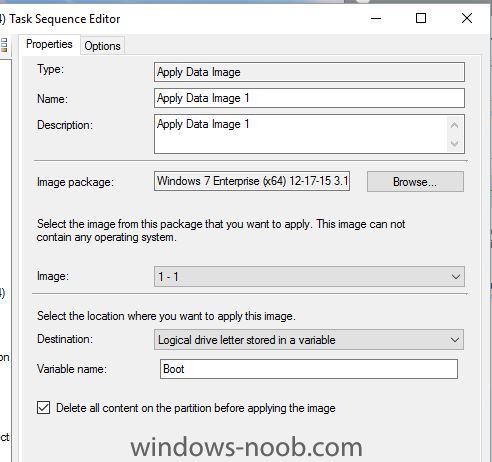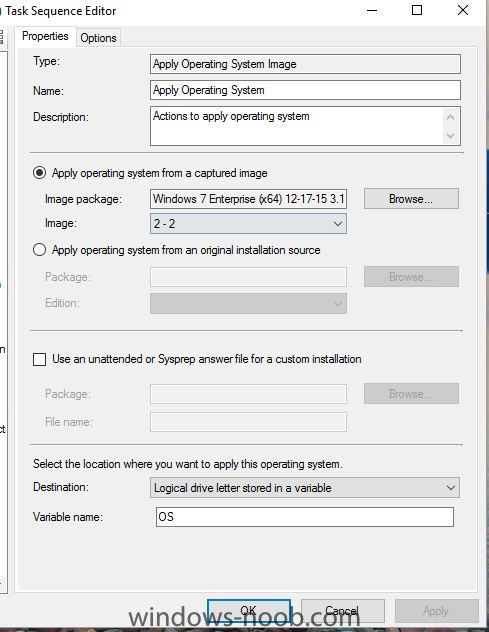-
Posts
13 -
Joined
-
Last visited
matt1234's Achievements
Newbie (1/14)
1
Reputation
-
This works really great thus far! We have only Win10 here at our site, however we run into instances where either a shared version for office is needed, to a standalone .msi for our warehouses. The drop down menu and variable logic allowed me to have multiple "Install applications" steps re-using the same variables. Works like a champ so far! I do have one question: Can someone maybe direct me to where I can modify/expand the image selection drop down menu?
-
Hi, I have a question regarding surface pro device firmware. We deploy Surface Pro 3s and Pro 4s at our entity. When a new driver/firmware pack is released from MS, we follow the usual instructions in downloading and applying the new driver/firmware pack to the devices. My question however is this- I noticed that if I run a manual windows update on either the surface pro 3 or pro 4, I see another system hardware update within the Windows update menu, when I know we have completed importing the newest drivers/firmware. Does anyone know why this is? I am guessing it is related to the touch panel itself, but I am looking to confirm. thanks.
-

Task Sequence Error - Unhandled Exception
matt1234 replied to ninjamanrenja's topic in Configuration Manager 2012
Following this post- Our facility is experiencing the same trouble.- 5 replies
-
- task sequence error
- unhandled exception
-
(and 1 more)
Tagged with:
-

OSD PXE strange issue
matt1234 replied to matt1234's question in Deploying Windows 10, Windows 8.1, Windows 7 and more...
Hi Thadkew, I will reach out and see if I can get ahold of it - and it happens to want to reboot. I'll have to talk to our IT admin onsite at that location and see if I he has any other information other than what I have been provided. From what I understand, there isn't any indication that the TS is going to reboot or not. One thing, that I will be sure to highlight is, when our admin there presses F12 to note what boot image ID and if there is any difference there. -

OSD PXE strange issue
matt1234 posted a question in Deploying Windows 10, Windows 8.1, Windows 7 and more...
Hi, Our main site has multiple locations, and a few of them within the US support and deploy our images from the main office via SCCM 2012 R2 SP1 CU3. We have been troubleshooting some network issues recently, that I believe we have cleaned up now. However during some deployment testing, we are experiencing some inconsistent results that I hope someone may have an answer or idea of where to look. -Created 4 VMs setup for OSD (testing/troubleshooting) all of the VMs are set for PXE. -All machines boot up and get to the PXE menu and populate the available task sequences with no issues. -Our guy has reported that he started the same task sequence to all the VMs at same time manually, where they all will download the boot image as so, and move forward onto the imaging process. -Anywhere from 2 out of the 4, to 3/4 of the VMs startup just fine and run the task sequence to completion. The other 1-2 (depending on the test run, it varies) will reboot and then launch within winPE and start the task sequence. I could be wrong here, but I believe usually when a TS reboots it is because the boot image from the PXE or boot media differs from the boot image assigned to the TS which makes sense. Though, given nothing is different from one VM to the other, the TS is the same...which has me scratching my head. My other theory(keyword theory) is our user is experiencing this upon the boot up itself while downloading the boot image from the bios menu. VM 2 is requesting this boot image that maybe "busy" at that very second due to VM 1 requesting it as well, forcing sccm to use another available boot image? - more than likely wrong here, nor does that really make sense to me, I'm just picking straws at this point. Has anyone run into this, or seen it before? Any thoughts, things to try? Thank you -
I know this is way late, time has gotten the best of me... So it turns out, that the issue according to a MS engineer our rep had referred us to, the intel "iastore.sys" driver for 6th generation (Skylake) CPUs (provided by Lenovo) conflicts with the surface pro NIC driver. We ended up creating a separate boot image for surface pro and book devices, and have called it done until we can re-explore this later. I didn't want to leave this one open ended, so hopefully if anyone runs across this post, it will be of some help/direction.
- 5 replies
-
- 1
-

-
- partitioning
- UEFI
-
(and 2 more)
Tagged with:
-
smsts.log Got it- not sure why it didn't actually apply last time.
- 5 replies
-
- partitioning
- UEFI
-
(and 2 more)
Tagged with:
-

Win 10: Failed to Save environment to
matt1234 replied to behemyth's question in Deploying Windows 10, Windows 8.1, Windows 7 and more...
What SCCM version are you using? Have you updated your adk to Win10? How are you trying to image these? (PXE,USB?) -
Hi, We having been deploying Surface devices for sometime now using SCCM R2 SP1 CU3, followed the guides posted here, and have had good luck with these for sometime now. We recently however had to warranty a few surface pro 3 devices for our users, and we are having alot of trouble getting these to format correctly, before failing the task sequence. Note: There have been 0 changes to the Task sequence for sometime, and we are able to image new units. Model: 256GB Surface Pro 3 back from service Prep for imaging: - Disable Secure boot/Clear all keys - Disable TPM - Secure Erase SSD (via surface data eraser tool provided by MS) - Created Offline (USB) Media Imaging: -SP3 starts and loads files to boot into WinPE -Machine name step pops up as normal Next Step, Format and Partition Disk (UEFI) - Hangs and eventually fails out stating that it cannot format the disk (log file attached). This problem remains true if I attempt to image via Offline media, with RMA units only. I left one of the RMA'd devices stock, joined the domain, loaded client, added to a collection and pushed the task sequence for testing/troubleshooting, and I took another Surface we've had on hand for a while, and ran the offline USB image through n through with no issues. The one thing that does stick out, is the internal hard drive vendor. From what we have seen, the majority of the surface units have a Samsung SSD, whereas the RMA units have a Hynix based SSD built in. Being it's a hard drive, the storage drivers should be the same for boot image being the chipset is the same, and vendor should not matter being the same sata protocol. Other than that, I cannot figure out a reason as to why this is happening. trying a new USB stick had no change as well. Has anyone run into or seen anything this before? Update: I found this article, that is basically pointing out the same problem, sadly no solution though- https://social.technet.microsoft.com/Forums/en-US/5a17cf36-d208-4264-ab66-9e483054bcc9/sccm-osd-task-sequence-stuck-at-formatting-c?forum=configmanagerosd - Another kicker, I was able to bring the trouble unit back to the factory image using the recovery USB media created earlier. I went ahead and attempted to image this thing the same way as the other unit- Join domain, add to collection, push TS to unit. Even THAT has failed at the exact same point, where it was no issue for the other one. I'll mess around a little more tomorrow.
- 5 replies
-
- partitioning
- UEFI
-
(and 2 more)
Tagged with:
-
I think I got it... Surface Pro 3 Driver Packages: - Win 8.1 (x64) Queries: - " Select * From Win32_ComputerSystem WHERE Model LIKE "%Surface Pro 3%" " - " Select * from Win32_OperatingSystem WHERE Version like "6.3%" AND ProductType="1" AND OSArchitecture = "64-bit" " With those added, this should allow the TS to identify which package to use depending on the desired deployed OS. Does this look correct?
- 2 replies
-
- Driver packages
- Query
-
(and 1 more)
Tagged with:
-
Hi, Our current Task sequence for the Surface pro devices has been working great for sometime. Now with our entity moving towards Windows 10, I'd like to just add on the driver package step in my task sequence to get the needed driver package at it's desired OS. Currently, I have one driver package for Surface devices with all drivers and firmware as shown in the tutorials provided from here. My current WMI query for identifying the device is the basic " Select * From Win32_ComputerSystem WHERE Model LIKE "%Surface Pro 3% " Which works fine for when you have two different generations of Surface Pro devices. With our WIn10 migration coming up, I've gone ahead and imported the Win 10 driver package into SCCM, but I need to find a find a better way to query the two different driver packs. Otherwise the TS will install both packages to the system, defeating the whole point... So, my question is- What is the best way to query the driver packages for the same device but each being guided at a different OS? (we need to keep both packages present for the time being) By OS? - with the builds of windows 10 changing every 8 months, how will this(if at all) affect my query? Any suggestions or wake up calls is always appreciated!
- 2 replies
-
- Driver packages
- Query
-
(and 1 more)
Tagged with:
-

OSD Fails to copy content to local disk
matt1234 replied to mpepprell's topic in Configuration Manager 2012
For Win 7 based machines depending how you captured, always make sure you have your image index's set correctly in the "Apply Operating System" and "Apply Data Image" steps. Apply OS Step: 2-2 Apply Data Image: 1-1 -
Hi, I recently have taken on the challenge of creating and deploying images within my company. Everything seems to be going ok, minus a couple GP objects not applying... Within my TS, I have it set to generate a local admin account with a generic PW to use in case I need to get into the machine. Once domain joined, and I log into my domain/admin account ok, and run a GP update. We have 3 local admin/service accounts that should be populating within the users/groups sections. However, they are not doing so. When I look at the event viewer logs under GP, there are no errors, warnings, etc.. Stating that everything is ok, finds objects, pulls objects down ok... Is there something else I can look at, or something I may have missed? I've attempting to search the net, but it mostly points to "how to" within a GPO template. I really need to get a lid on this one, any help/direction is greatly appreciated. Thank you ,
-
- Group Policy
- OSD
-
(and 1 more)
Tagged with:




